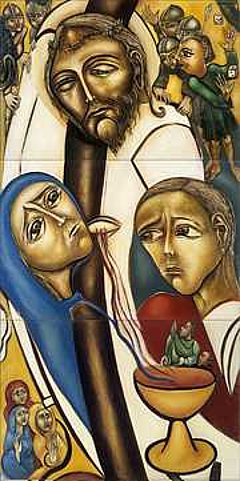
An "obligatory liturgical memorial"
In the present Roman missal, the readings of September 15th continue the readings of Good Friday, since they are an invitation to revisit Good Friday in a Marian perspective. The Virgin gives birth to the children that God saved by suffering until death by bringing them to the true life,.
A feast based on Scripture
Devotion to the Mother of the Lord in the mystery of her sorrows is very old, but it only entered the liturgy later.
This attention of the faithful to Mary’s pain takes its source in Scripture, notably in the references to:
o The prophecy of Simeon (Lk 2: 34-35)
o The loss of Jesus at the age of twelve (Lk 2: 51-52)
o The time in which the Son is told he has lost his mind (cf. Mk 3: 20-21; 22-30).
o The mother standing near the cross (cf Jn 19:25).
The multiple roots of this feast:
Each country sees an aspect of it and highlights it.
No religious family or people can claim to have invented this feast.
The feast was born around the same time in different places.
In the East, the participation of Mary in the suffering of the Redeemer was evoked early on, in patristic texts: Ephrem, Romanos the Melodist.
In the West, the Benedictines of Cluny and Saint Anselm of Canterbury (born in Aosta), the Cistercian movement (with St Bernard’s eloquent but not particularly original writings), the Franciscans with their attention to the humanity of Christ (the manger, the cross, universal salvation, the glorious cross made rich with Christ… before that Christ was not represented on the cross), and the Servants of Mary.
A variety of perspectives, a variety of titles
1. Mary next to the cross is the "new Eve" (with Christ as the New Adam).
2. The "Queen of Martyrs": she did not suffer the same fate but the acuity of their suffering.
3. The cross is for Mary the hour of childbirth.
4. The hour of the transfixion (piercing) of the heart of the Virgin, the sword announced by Simeon.
5. The figure of the pietà: Mary receiving the body of her Christ descended from the cross.
6. Mary’s tears.
7. Compassion: the mother'Erreur ! Référence de lien hypertexte non valide.s compassion for the Son, and secondly, the faithful who sympathize with Mary.
8. The solitude of Mary.
Each local Church highlights one aspect.